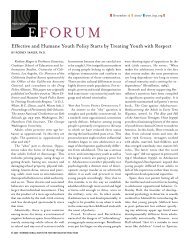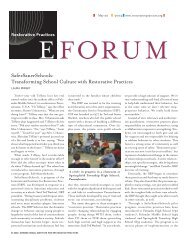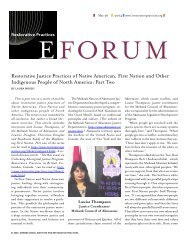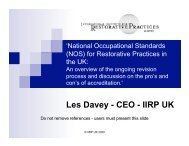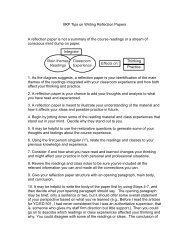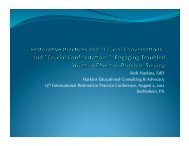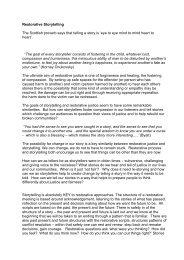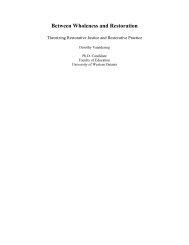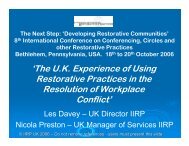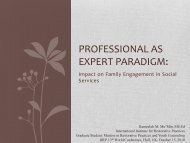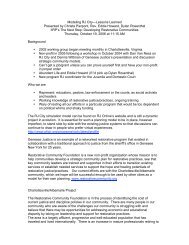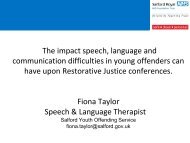Applying Restorative Justice to Higher/Tertiary Education in ... - IIRP
Applying Restorative Justice to Higher/Tertiary Education in ... - IIRP
Applying Restorative Justice to Higher/Tertiary Education in ... - IIRP
Create successful ePaper yourself
Turn your PDF publications into a flip-book with our unique Google optimized e-Paper software.
<strong>Res<strong>to</strong>rative</strong> <strong>Justice</strong><br />
Key Concepts<br />
Harm: Harm may <strong>in</strong>clude physical damage<br />
<strong>to</strong> person or property, but it often <strong>in</strong>volves<br />
damage that is less visible. While the tangible<br />
effects of physical harm may fade with time,<br />
other types of harm do not fade as fast,<br />
<strong>in</strong>clud<strong>in</strong>g:<br />
• Fear of others<br />
• Loss of self-esteem<br />
• Loss of reputation<br />
• Ongo<strong>in</strong>g anxiety<br />
• Academic disruption<br />
• Damaged relationships<br />
Repair<strong>in</strong>g the Harm: Mak<strong>in</strong>g th<strong>in</strong>gs right<br />
is the goal of res<strong>to</strong>rative justice. There are a<br />
number of ways that this can occur, <strong>in</strong>clud<strong>in</strong>g:<br />
• An apology (written or verbal)<br />
• Repair<strong>in</strong>g damaged property<br />
• <strong>Education</strong>al project for personal growth<br />
• Community service project (related <strong>to</strong><br />
<strong>in</strong>cident)<br />
“<strong>Res<strong>to</strong>rative</strong> justice encourages outcomes that promote<br />
responsibility, reparation, and heal<strong>in</strong>g for all.”<br />
‐Howard Zehr,<br />
The Little Book of <strong>Res<strong>to</strong>rative</strong> <strong>Justice</strong><br />
Community Circle<br />
Referral Process<br />
1. Hall direc<strong>to</strong>r/hear<strong>in</strong>g officer reviews the<br />
<strong>in</strong>cident and decides if the case is<br />
appropriate for a community circle.<br />
2. The respondent student accepts<br />
responsibility and agrees <strong>to</strong> participate.<br />
3. The community circle is scheduled with<br />
assistance from HSCR staff.<br />
4. The circle occurs. A written agreement is<br />
created for the respondent <strong>to</strong> complete.<br />
5. Once the responsibilities outl<strong>in</strong>ed <strong>in</strong> the<br />
agreement are fulfilled, the community<br />
circle process is complete and the case is<br />
closed.<br />
Respondent Reactions<br />
• “It really helped us open up <strong>to</strong> what happened,<br />
and made us learn how <strong>to</strong> fix it and make better<br />
decisions.”<br />
• “I feel that we are giv<strong>in</strong>g back <strong>to</strong> those affected.”<br />
• “It’s the best learn<strong>in</strong>g experience. Everyone will<br />
benefit from this meet<strong>in</strong>g.”<br />
• “By hear<strong>in</strong>g it directly from [the community,] it<br />
helped me realize how I affected them. It was a<br />
reconcil<strong>in</strong>g experience.”<br />
• “It is a positive and reflective process with good<br />
results.”<br />
Community Circle<br />
Step-by-Step<br />
No two community circle meet<strong>in</strong>gs are alike,<br />
but there is a process that is followed:<br />
Welcome – Participants are greeted; goals<br />
and ground rules are reviewed.<br />
Tell<strong>in</strong>g the S<strong>to</strong>ry – Each participant is able<br />
<strong>to</strong> share their thoughts and feel<strong>in</strong>gs about<br />
the <strong>in</strong>cident. Levels of harm will be<br />
discussed.<br />
Bra<strong>in</strong>s<strong>to</strong>rm<strong>in</strong>g Options – After everyone<br />
has discussed the <strong>in</strong>cident, participants will<br />
bra<strong>in</strong>s<strong>to</strong>rm options <strong>to</strong> repair the harm<br />
caused by the misconduct.<br />
<strong>Res<strong>to</strong>rative</strong> Agreement – With <strong>in</strong>put<br />
from the entire group, a res<strong>to</strong>rative<br />
agreement is f<strong>in</strong>alized that <strong>in</strong>cludes an<br />
outl<strong>in</strong>e of how and when tasks/projects will<br />
be completed.<br />
Closure – Facilita<strong>to</strong>rs provide formal closure<br />
<strong>to</strong> the circle, <strong>in</strong>clud<strong>in</strong>g offer<strong>in</strong>g <strong>in</strong>formation<br />
on agreement accountability and<br />
opportunities for follow-up. Each<br />
participant will also be asked <strong>to</strong> fill out an<br />
evaluation of the session.



